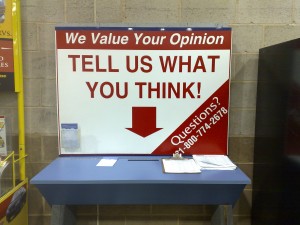The Concept Of Retail Momentum: Feed The Beast Or Lose It
- May
- 09
- Posted by Ben Smith
- Posted in Blog, By Ben Smith, Educational
- 3

In physics, momentum defined as the product of the mass and velocity of an object (p = mv). In life, momentum is when things are going good and keep on getting better. In sports, when teams go on a winning streak, it is often referred to as “The Big Mo”. However you define it – once you’ve got it, you want to keep it. And when you lose it, you may have to work twice as hard to regain it – if you are ever lucky enough to get momentum again.
WHAT IS RETAIL MOMENTUM?
Now look at momentum from a retail perspective. Here at Retail Leverage, we’re defining Retail Momentum as when your sales velocity reaches critical mass. The definition works at all levels – it can occur in a single store, category, retailer, channel, or the entire market. Of course getting your sales to a high level and sustaining them is easier said than done.
This is probably a good time to tell you this article isn’t about how to achieve a high level of sales and gain momentum. It’s about understanding Retail Momentum and ideas to keep from losing momentum.
Note – this article is written through the lens of a consumer electronics marketer, and it proudly reflects the scars of insanely short lifecycles, ridiculous promotions, merciless partners, and painful paths to profit. I think the concepts shared and ideas we are trying to generate will apply across multiple consumer segments, but I wanted you to know where they came from.
RETAIL MOMENTUM – USE IT OR LOSE IT:
Frankly at some point everybody and every brand has their moment in the sun. There are enough levers you can pull that it is possible to get virtually any product to a high level of sales for a period of time. That’s not the problem. It’s not about being #1, it’s about sustaining it. Well – that doesn’t tell the whole story. So far everything I’ve said is from the brand perspective. Me Me Me. Us Us Us. Here at Retail Leverage we continually argue that selling at retail is not about your own product or brand – it’s ultimately all about the retailer. Them Them Them.
So what is the key thing you need to understand?
 Your products are ultimately a profit delivery mechanism for the retailer. The sooner you recognize it, the better. You are feeding a beast. If you don’t feed the beast, somebody else will. If you are feeding the beast successfully, and the beast wants more – you have to find a way to keep feeding it. Even in the short term, you can gain Retail Leverage by helping the retailer become somewhat dependent on you. As long as you keep feeding the beast. As long as you keep the momentum.
Your products are ultimately a profit delivery mechanism for the retailer. The sooner you recognize it, the better. You are feeding a beast. If you don’t feed the beast, somebody else will. If you are feeding the beast successfully, and the beast wants more – you have to find a way to keep feeding it. Even in the short term, you can gain Retail Leverage by helping the retailer become somewhat dependent on you. As long as you keep feeding the beast. As long as you keep the momentum.

If you could give some retail truth serum to a veteran of retail sales or marketing, I expect you’d be able to get an admission that one of their biggest regrets revolves around when whatever they were selling had momentum, but due to certain actions (or lack of) they lost that momentum. Just for the sake of honesty, to get you to open up, I’ll admit that I’ve got my own personal list of 4 or 5 times where what I was selling/marketing had momentum and let it slip away. I’m not sharing the specifics here 🙂 because the who what when where aren’t important, but recognizing past failures is important to making sure you don’t repeat those same mistakes. I’m pretty sure I’m not the only one reading this – I’m sure you can easily identify similar situations in your own retail life.
IDEAS TO KEEP (OR NOT LOSE) MOMENTUM AT RETAIL:
The 4P’s are as good of a place as any to start. Here’s the list, with some background on each.
- Keep exact PRODUCT alive as long as possible.
- Keep your PRICING and PROMOTION consistent.
- Keep in PLACE support for your existing distribution.
Keep exact PRODUCT alive as long as possible.
Imagine a product that has finally broken through at retail. You got close with several previous products, but this time you have set your world on fire. The stores can’t get seem to get enough, customers come in asking for it, and the store staff describe it with that classic line “it sells itself”. So why would you want to stop a good thing? Do you blindly follow the product roadmap (designed long before your product hit the shelves and then flew off them)? If you still have the ability to keep the manufacturing lines going – do so.
 You will likely know what you have on your hands well in advance of any critical decisions such as with manufacturing or retail resets. Don’t you hate it when the old adage “a bird in the hand is worth two in the bush” is true. In this case it can be. The roadmap wouldn’t matter if the replacement was going to be late anyway, which is proof enough that you can try keeping the existing product going longer than initially planned.
You will likely know what you have on your hands well in advance of any critical decisions such as with manufacturing or retail resets. Don’t you hate it when the old adage “a bird in the hand is worth two in the bush” is true. In this case it can be. The roadmap wouldn’t matter if the replacement was going to be late anyway, which is proof enough that you can try keeping the existing product going longer than initially planned.
Keep your PRICING and PROMOTION consistent.
 Have you ever been in a car where the driver speeds up, then slams on the brakes. Speeds up again. Slams the brakes again. Or even worse, when the driver gets upset, they pull over to the side of the road, yank the keys out and throw them on the dash. Now imagine this in retail terms. If you use promotions to drive sales, and that is what has gotten you to the promised land where you have Retail Momentum, it doesn’t make sense to immediately turn them off. Nothing leaves a buyer’s head spinning faster than the brand who used to come in slinging guns and then puts their hands up. The buyer doesn’t care why you do what you do, as long as you do it and are consistent. More to the point – the buyer doesn’t care if your pricing and promotions aren’t sustainable as long as you are driving sales for them.
Have you ever been in a car where the driver speeds up, then slams on the brakes. Speeds up again. Slams the brakes again. Or even worse, when the driver gets upset, they pull over to the side of the road, yank the keys out and throw them on the dash. Now imagine this in retail terms. If you use promotions to drive sales, and that is what has gotten you to the promised land where you have Retail Momentum, it doesn’t make sense to immediately turn them off. Nothing leaves a buyer’s head spinning faster than the brand who used to come in slinging guns and then puts their hands up. The buyer doesn’t care why you do what you do, as long as you do it and are consistent. More to the point – the buyer doesn’t care if your pricing and promotions aren’t sustainable as long as you are driving sales for them.
Keep in PLACE support for your existing distribution.
 Now is not the time to get greedy. If you’ve ever heard the term “dance with the one who brought you”, think about that in retail terms. So you’ve got this great product/brand that everybody wants a piece of. That’s a great problem to have. But remember where you came from and who got you there. Focus on keeping the existing beast fed before you start to open up new retailers / channels. Proceed with caution. The less track record you have, the more important this ideas is. I always wonder what is more memorable in a buyer’s mind – if your product sells but you supported them well; or if your product was hot but you always disappointed them with out of stocks, missed shipments. Buyers have long memories, and they move around often. So even if it might not come back to bite you in your current position, it could in the future.
Now is not the time to get greedy. If you’ve ever heard the term “dance with the one who brought you”, think about that in retail terms. So you’ve got this great product/brand that everybody wants a piece of. That’s a great problem to have. But remember where you came from and who got you there. Focus on keeping the existing beast fed before you start to open up new retailers / channels. Proceed with caution. The less track record you have, the more important this ideas is. I always wonder what is more memorable in a buyer’s mind – if your product sells but you supported them well; or if your product was hot but you always disappointed them with out of stocks, missed shipments. Buyers have long memories, and they move around often. So even if it might not come back to bite you in your current position, it could in the future.
CALL TO ACTION: SHARE YOUR IDEAS TO KEEP MOMENTUM AT RETAIL:
 I got the conversation started, but since we’ve been so honest throughout this article, I kept it pretty basic. The 4P’s are great for Marketing 101, but there are nuances to every category and segment of retail that you can’t wrap up with a pretty bow. So I challenge our readers to share their ideas on how to keep momentum at retail. I’ll compile the ideas I get via comments, tweets, and email and update this article in a few days.
I got the conversation started, but since we’ve been so honest throughout this article, I kept it pretty basic. The 4P’s are great for Marketing 101, but there are nuances to every category and segment of retail that you can’t wrap up with a pretty bow. So I challenge our readers to share their ideas on how to keep momentum at retail. I’ll compile the ideas I get via comments, tweets, and email and update this article in a few days.

Tags
Subscribe
Follow Us
Recent Posts
- Take Your Design Business To The Next Level
- What Is Your Retail Leverage Factor?
- More Margin More Retail Problems?
- Retail Leverage – An Agency Executive’s Perspective
- How To Maxx Out Retail er Leverage (With Unwilling Help From Apple’s IPAD)
- All Hail the Kings of Retail Leverage – Monster Cable
- Shelf potato alert – Microsoft Kin mobile phone
- What Is A Shelf Potato?
- Martha Stewart Called To Carpet For Benefiting From A Legal Trade
- Forget Perfection – Just Worry About Good Enough
- Sharp Quattron TV’s Add Yellow But Their Marketing Makes Me Blue
- Product Specification: A Shield in the Battle Against Private Label at Retail
- The Concept Of Retail Momentum: Feed The Beast Or Lose It
- Want To Gain Big Dollar and Lots of Leverage In General At Retail? Look Closely To Find The Answer.
- Understand Retailer Private Brand Strategy By Watching Football

Great post. I’m particularly fond of your note NOT to change product too quickly.
In marketing departments, we often feel we aren’t doing our jobs if there’s not new product coming out constantly. Seems we need a betteer discipline asking “are these changes the result of market need or are they merely changes because that’s the thing to do”?
I’d suggest the same is true with advertising. In direct response advertising we regularly find that good campaigns will pay out for years without major creative modifications. But often companies are heir worst enemies here – seeking change only for changes sake.
Not to say that some industries (tech especially) don’t have much higher needs for change. We just always need to know why change is sought.
[…] The product started well and lost momentum. This excellent post from RetailLeverage discusses important steps for maintaining momentum. For example, “Keep the exact product on the shelf for as long as possible.” (I’m […]
[…] – thereby increasing the price people will pay? 7. The product started well and lost momentum. This excellent post from RetailLeverage discusses important steps for maintaining momentum. For example, “Keep the exact product on the shelf for as long as possible.” (I’m reminded of […]